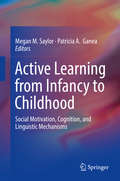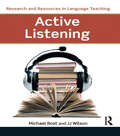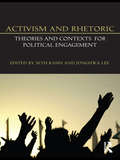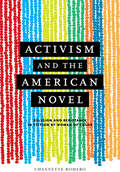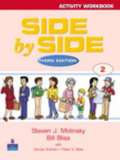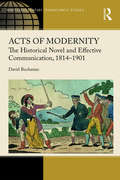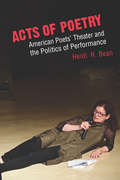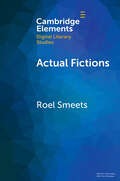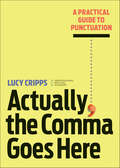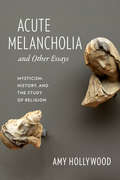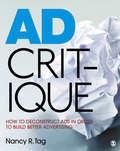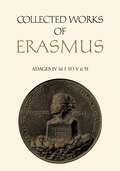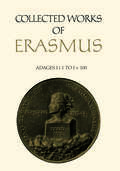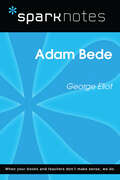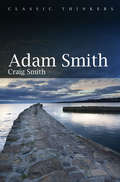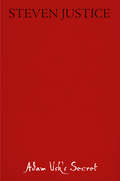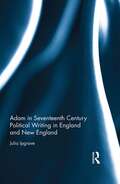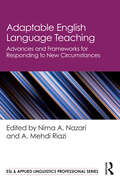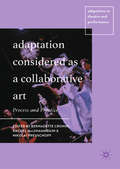- Table View
- List View
Active Learning from Infancy to Childhood: Social Motivation, Cognition, And Linguistic Mechanisms
by Megan M. Saylor Patricia A. GaneaThis book presents new findings on the role of active learning in infants’ and young children’s cognitive and linguistic development.<P><P> Chapters discuss evidence-based models, identify possible neurological mechanisms supporting active learning, pinpoint children’s early understanding of learning, and trace children’s recognition of their own learning. Chapters also address how children shape their lexicon, covering a range of active learning practices including interactions with parents, teachers, and peers; curiosity and exploration during play; seeking information from other people and their surroundings; and asking questions. In addition, processes of selective learning are discussed, from learning new words and trusting others in acquiring information to weighing evidence and accepting ambiguity. <P> Topics featured in this book include: Infants’ active role in language learning; The process of active word learning; Understanding when and how explanation promotes exploration; How conversations with parents can affect children’s word associations; Evidence evaluation for active learning and teaching in early childhood; Bilingual children and their role as language brokers for their parents. <P>Active Learning from Infancy to Childhood is a must-have resource for researchers, clinicians and related professionals, and graduate students in developmental psychology, psycholinguistics, educational psychology, and early childhood education.
Active Listening (Research and Resources in Language Teaching)
by Michael Rost J. J. WilsonListening is now regarded by researchers and practitioners as a highly active skill involving prediction, inference, reflection, constructive recall, and often direct interaction with speakers. In this new theoretical and practical guide, Michael Rost and JJ Wilson demonstrate how active listening can be developed through guided instruction. With so many new technologies and platforms for communication, there are more opportunities than ever before for learners to access listening input, but this abundance leads to new challenges: how to choose the right input how to best use listening and viewing input inside and outside the classroom how to create an appropriate syllabus using available resources Active Listening explores these questions in clear, accessible prose, basing its findings on a theoretical framework that condenses the most important listening research of the last two decades. Showing how to put theory into practice, the book includes fifty innovative activities, and links each one to relevant research principles. Sample audio recordings are also provided for selected activities, available online at the series website www.pearsoned.co.uk/rostwilson. As a bridge between theory and practice, Active Listening will encourage second language teachers, applied linguists, language curriculum coordinators, researchers, and materials designers to become more active practitioners themselves, by more fully utilising research in the field of second language listening.
Activism and Rhetoric: Theories and Contexts for Political Engagement
by Seth Kahn JongHwa LeeThis volume examines the role of rhetoric in today’s culture of democratic activism. The volume takes on two of the most significant challenges currently facing contemporary rhetorical studies: (1) the contested meanings and practices of democracy and civic engagement in global context, and (2) the central role of rhetoric in democratic activist practices. In presenting a variety of political and rhetorical struggles in their specific contexts, editors Seth Kahn and JongHwa Lee allow contributors to reflect on and elaborate possibilities for both activist approaches to rhetorical studies, and rhetorical approaches to activist projects, facilitating better understanding the socio-political consequences of this work. With contributors from widely known scholars in communication and composition studies, the collection offers practical cases that highlight how rhetoric mediates, constitutes, and/or intervenes in democratic principles and practices. It also considers theoretical questions that acknowledge profound voids in the rhetorical tradition (e.g., Western, neo-Aristotelian, liberal) and expand the horizon of traditional rhetorical perspectives. It advocates new knowledge and practices that further promote civic engagement, social change and democracy in the global context. Activism and Rhetoric will be appropriate for scholars and students across disciplines, including rhetoric, composition, communication studies, political science, cultural studies, and women’s studies.
Activism and Rhetoric: Theories and Contexts for Political Engagement
by Seth Kahn JongHwa LeeThe second edition of this formative collection offers analysis of the work rhetoric plays in the principles and practices of today’s culture of democratic activism. Editors JongHwa Lee and Seth Kahn—and their diverse contributors working in communication and composition studies both within and outside academia—provide explicit articulation of how activist rhetoric differs from the kinds of deliberative models that rhetoric has exalted for centuries, contextualized through and by contributors’ everyday lives, work, and interests. New to this edition are attention to Black Lives Matter, the transgender community, social media environments, globalization, and environmental activism. Simultaneously challenging and accessible, Activism and Rhetoric: Theories and Contexts for Political Engagement is a must-read for students and scholars who are interested in or actively engaged in rhetoric, composition, political communication, and social justice.
Activism and the American Novel: Religion and Resistance in Fiction by Women of Color
by Channette RomeroSince the 1980s, many activists and writers have turned from identity politics toward ethnic religious traditions to rediscover and reinvigorate their historic role in resistance to colonialism and oppression. In her examination of contemporary fiction by women of color—including Toni Morrison, Ana Castillo, Toni Cade Bambara, Louise Erdrich, and Leslie Marmon Silko—Channette Romero considers the way these novels newly engage with Vodun, Santería, Candomblé, and American Indian traditions. Critical of a widespread disengagement from civic participation and of the contemporary novel’s disconnection from politics, this fiction attempts to transform the novel and the practice of reading into a means of political engagement and an inspiration for social change.
Activity Book 1, Comprehension and Skill Work, Units 1-7
by Sopris West Educational ServicesA Level One reading comprehension workbook.
Activity Book, Grade 5, Unit 2: Early American Civilizations
by Core Knowledge FoundationNIMAC-sourced textbook
Activity Workbook: Side By Side Book 2 (Third Edition)
by Steven J. Molinsky Bill Bliss Carolyn Graham Peter S. BlissThe Side by Side Activity Workbooks offer a variety of exercises for reinforcement, fully coordinated with the student texts. A special feature of the Activity Workbooks is the inclusion of GrammarRaps for practice with rhythm, stress, and intonation and GrammarSongs from the Side by Side TV videos. Periodic check-up tests are also included in the workbooks. Side by Side Plus is a standards-based and grammar-based English language program for adult and young-adult learners, The program builds students’ general language proficiency and prepares them for their life-skill roles in the community, family, school, and at work.
Acts of Modernity: The Historical Novel and Effective Communication, 1814–1901 (Ashgate Series in Nineteenth-Century Transatlantic Studies)
by David BuchananIn Acts of Modernity, David Buchanan reads nineteenth-century historical novels from Scotland, America, France, and Canada as instances of modern discourse reflective of community concerns and methods that were transatlantic in scope. Following on revolutionary events at home and abroad, the unique combination of history and romance initiated by Walter Scott’s Waverley (1814) furthered interest in the transition to and depiction of the nation-state. Established and lesser-known novelists reinterpreted the genre to describe the impact of modernization and to propose coping mechanisms, according to interests and circumstances. Besides analysis of the chronotopic representation of modernity within and between national contexts, Buchanan considers how remediation enabled diverse communities to encounter popular historical novels in upmarket and downmarket forms over the course of the century. He pays attention to the way communication practices are embedded within and constitutive of the social lives of readers, and more specifically, to how cultural producers adapted the historical novel to dynamic communication situations. In these ways, Acts of Modernity investigates how the historical novel was repeatedly reinvented to effectively communicate the consequences of modernity as problem-solutions of relevance to people on both sides of the Atlantic.
Acts of Poetry: American Poets' Theater and the Politics of Performance
by Heidi R BeanAmerican poets’ theater emerged in the postwar period alongside the rich, performance-oriented poetry and theater scenes that proliferated on the makeshift stages of urban coffee houses, shared apartments, and underground theaters, yet its significance has been largely overlooked by critics. Acts of Poetry shines a spotlight on poets’ theater’s key groups, practitioners, influencers, and inheritors, such as the Poets’ Theatre, the Living Theatre, Gertrude Stein, Bunny Lang, Frank O’Hara, Amiri Baraka, Carla Harryman, and Suzan-Lori Parks. Heidi R. Bean demonstrates the importance of poets’ theater in the development of twentieth-century theater and performance poetry, and especially evolving notions of the audience’s role in performance, and in narratives of the relationship between performance and everyday life. Drawing on an extensive archive of scripts, production materials, personal correspondence, theater records, interviews, manifestoes, editorials, and reviews, the book captures critical assessments and behind-the-scenes discussions that enrich our understanding of the intertwined histories of American theater and American poetry in the twentieth century.
Actual Fictions: Literary Representation and Character Network Analysis (Elements in Digital Literary Studies)
by Roel SmeetsThis Element sheds a new light on the ubiquitous yet complex notion of mimesis. By systematically comparing the social dynamics of the Dutch population at a given time with the social dynamics of characters in Dutch literary fiction published in the same period, it aims to pinpoint the ways in and the extent with which literary fiction either mirrors or shapes the societal context from which it emerged. While close-reading-based scholarship on this topic has been limited to qualitative interpretations of allegedly exemplary works, the present study uses the data-driven tools of social network analysis to systematically determine the imitative elements of the social dynamics of characters within larger-scale, representative collections of books of literary fiction.
Actually, the Comma Goes Here: A Practical Guide to Punctuation
by Lucy CrippsFun, funny, and factual—the most complete guide to punctuation for beginners and experts alike. Period.No one's ever said that learning punctuation is fun—until now. Actually, The Comma Goes Here takes a lighthearted yet highly informative approach to ensuring you never misplace a comma again.Whether it's semicolons or exclamation points, this primer has you covered with chapters that dive deep into the correct use for each and every piece of punctuation. You'll find plenty of fun (and funny) examples of proper writing while also learning how punctuation has changed throughout history.Actually, The Comma Goes Here includes:A complete crash course—Keep things simple with chapters that progress from the most basic punctuation (like periods) to more advanced or uncommon punctuation (like brackets).Memorable advice—Never mix your clauses up again thanks to easy-to-remember breakdowns, handy mnemonics, and entertaining sample sentences.Matters of style—Discover a quick reference chart that details the differences between the most common style guides, including the Chicago Manual of Style and Associated Press.Perfect your punctuation with the help of this comprehensive guidebook.
Acute Melancholia and Other Essays: Mysticism, History, and the Study of Religion (Gender, Theory, and Religion)
by Amy HollywoodAcute Melancholia and Other Essays deploys spirited and progressive approaches to the study of Christian mysticism and the philosophy of religion. Ideal for novices and experienced scholars alike, the volume makes a forceful case for thinking about religion as both belief and practice, in which traditions marked by change are passed down through generations, laying the groundwork for their own critique. Through a provocative integration of medieval sources and texts by Jacques Derrida, Judith Butler, Talal Asad, and Dipesh Chakrabarty, this book redefines what it means to engage critically with history and those embedded within it.
Ad Critique: How to Deconstruct Ads in Order to Build Better Advertising
by Nancy R. TagAd Critique teaches advertising, marketing, and management students--both the "suits" and the "creatives"--how to effectively judge and critique creativity in advertising. This textbook is an instruction manual; a facilitator of dialogue; a companion piece to classroom content. Its lessons result in actual skills that enable students to look at the creative product and embolden them to say something constructive and worthwhile.
Adages IV iii 1 to V ii 51: Adages Iv Iii 1 To V Ii 51 (Collected Works of Erasmus #36)
by John Grant Desiderius Erasmus Betty Knott-SharpeThis sixth of seven volumes devoted to the Adages in the Collected Works of Erasmus completes the translation and annotation of the more than 4000 proverbs gathered and commented on by Erasmus in his Adagiorum Chiliades (Thousands of Adages, usually known more simply as the Adagia). This volume’s aim, like that of the others, is to provide a fully annotated, accurate, and readable English version of Erasmus' commentaries on these Greek and Latin proverbs, and to show how Erasmus continued to expand this work, originally published in 1508, until his death in 1536. An indication of Erasmus' unflagging interest in classical proverbs is that almost 500 of the 951 adages translated in this volume did not make their first appearance until the edition of 1533. Following in the tradition of meticulous scholarship for which the Collected Works of Erasmus is widely known, the notes to this volume identify the classical sources and illustrate how the content of his commentaries on the adages often reflects Erasmus' scholarly and editing interests in the classical authors at a particular time. The work was highly acclaimed and circulated widely in Erasmus' time, serving as a conduit for transmitting classical proverbs into the vernacular languages, in which many of the proverbs still survive to this day. Volume 36 of the Collected Works of Erasmus series.
Adages: Ii1 to Iv100
by Desiderius Erasmus Margaret Mann Phillips R.A.B. MynorsErasmus' Adagia has been called 'one of the world's biggest bedside books,' and certainly the more than 4000 proverbs and maxims gathered and commented on by Erasmus, sometimes in a few lines and sometimes in full-scale essays, have great appeal for both scholar and educated layman. The aim of the Adages was to recapture, in this handy portmanteau form, the outlook and way of life of the classical world through its customs, legends, and social institutions, and to put within reach of a modern public the accumulated wisdom of the past. Each adage is traced in the works of as many authors as Erasmus had to hand; always an authority is given (usually several) and often a close reference providing chapter and verse. The commentaries in the Adages give a forthright and often eloquent expression of Erasmus' opinions on the world of his day, dovetailing with his satirical works on the one hand and his popular evangelical writings on the other. Many, if not most, of the proverbs cited by Erasmus are still in our common stock of speech today. The Collected Works of Erasmus is providing the first complete translation of Erasmus' Adagia. This volume contains the initial 300 adages with notes that identify the classical sources and indicate how Erasmus' reading and thinking developed over the quarter-century spanned by the eight revisions of the original work. Volume 31 of the Collected Works of Erasmus series.
Adam Bede (SparkNotes Literature Guide Series)
by SparkNotesAdam Bede (SparkNotes Literature Guide) by Geoge Elliot Making the reading experience fun!Created by Harvard students for students everywhere, SparkNotes is a new breed of study guide: smarter, better, faster.Geared to what today's students need to know, SparkNotes provides:chapter-by-chapter analysisexplanations of key themes, motifs, and symbolsa review quiz and essay topicsLively and accessible, these guides are perfect for late-night studying and writing papers.
Adam Smith: A Primer (Classic Thinkers)
by Craig SmithAlmost everyone has heard of Adam Smith, founding father of modern economics and author of Wealth of Nations. There is, however, much more to him than this. This new introduction gives a crystal clear overview of the entirety of Smith’s thought. It demonstrates how Smith’s economic theories fit into a larger system of thought that encompasses moral philosophy, philosophy of science, legal and political theory, and aesthetics. Examining the central arguments of his major works, ranging from The Theory of Moral Sentiments to his lectures on jurisprudence and beyond, Smith’s thought is explained in its full intellectual and historical context. As the book unfolds, the long-standing caricature of Adam Smith as an uncritical defender of capitalism red in tooth and claw is systematically challenged, revealing a far more complex and nuanced figure whose rich legacy remains highly relevant today. Comprehensive yet concise, this book will be the leading introduction to Adam Smith’s ideas for generations of students, scholars and general readers, relevant to areas ranging from philosophy and the history of economic thought to political theory.
Adam Smith’s Moral Sentiments in Vanity Fair: Lessons in Business Ethics from Becky Sharp (Issues in Business Ethics #49)
by Rosa SlegersAccording to Adam Smith, vanity is a vice that contains a promise: a vain person is much more likely than a person with low self-esteem to accomplish great things. Problematic as it may be from a moral perspective, vanity makes a person more likely to succeed in business, politics and other public pursuits. “The great secret of education,” Smith writes, “is to direct vanity to proper objects:” this peculiar vice can serve as a stepping-stone to virtue. How can this transformation be accomplished and what might go wrong along the way? What exactly is vanity and how does it factor into our personal and professional lives, for better and for worse?This book brings Smith’s Theory of Moral Sentiments into conversation with William Makepeace Thackeray’s Vanity Fair to offer an analysis of vanity and the objects (proper and otherwise) to which it may be directed. Leading the way through the literary case study presented here is Becky Sharp, the ambitious and cunning protagonist of Thackeray’s novel. Becky is joined by a number of other 19th Century literary heroines – drawn from the novels of Jane Austen, Charlotte Brontë and George Eliot – whose feminine (and feminist) perspectives complement Smith’s astute observations and complicate his account of vanity. The fictional characters featured in this volume enrich and deepen our understanding of Smith’s work and disclose parts of our own experience in a fresh way, revealing the dark and at times ridiculous aspects of life in Vanity Fair, today as in the past.
Adam Usk's Secret
by Steven JusticeAdam Usk, a Welsh lawyer in England and Rome during the first years of the fifteenth century, lived a peculiar life. He was, by turns, a professor, a royal advisor, a traitor, a schismatic, and a spy. He cultivated and then sabotaged figures of great influence, switching allegiances between kings, upstarts, and popes at an astonishing pace. Usk also wrote a peculiar book: a chronicle of his own times, composed in a strangely anxious and secretive voice that seems better designed to withhold vital facts than to recount them. His bold starts tumble into anticlimax; he interrupts what he starts to tell and omits what he might have told. Yet the kind of secrets a political man might find safer to keep--the schemes and violence of regime change--Usk tells openly. Steven Justice sets out to find what it was that Adam Usk wanted to hide. His search takes surprising turns through acts of political violence, persecution, censorship--and, ultimately, literary history. Adam Usk's narrow, eccentric literary genius calls into question some of the most casual and confident assumptions of literary criticism and historiography, making stale rhetorical habits seem new. Adam Usk's Secret concludes with a sharp challenge to historians over what they think they can know about literature and to literary scholars over what they think they can know about history.
Adam in Seventeenth Century Political Writing in England and New England
by Julia IpgraveDesigned to contribute to a greater understanding of the religious foundations of seventeenth century political writing, this study offers a detailed exploration of the significance of the figure and story of Adam at that time. The book investigates seventeenth-century writings from England and New England-examining writings by Roger Williams and John Eliot, Gerrard Winstanley, John Milton, and John Locke-to explore the varying significance afforded to the Biblical figure of Adam in theories of the polity. In so doing, it counters over-simplified views of modern secular political thought breaking free from the confines of religion, by showing the diversity of political models and possibilities that Adamic theories supported. It provides contextual background for the appreciation of seventeenth-century culture and other cultural artefacts, and feeds into current scholarly interest in the relationship between religion and the public sphere, and in stories of origins and Creation.
Adam's Tongue: How Humans Made Language, How Language Made Humans
by Derek BickertonHow language evolved has been called "the hardest problem in science. " In Adam's Tongue, Derek Bickerton--long a leading authority in this field--shows how and why previous attempts to solve that problem have fallen short. Taking cues from topics as diverse as the foraging strategies of ants, the distribution of large prehistoric herbivores, and the construction of ecological niches, Bickerton produces a dazzling new alternative to the conventional wisdom. Language is unique to humans, but it isn't the only thing that sets us apart from other species--our cognitive powers are qualitatively different. So could there be two separate discontinuities between humans and the rest of nature? No, says Bickerton; he shows how the mere possession of symbolic units--words--automatically opened a new and different cognitive universe, one that yielded novel innovations ranging from barbed arrowheads to the Apollo spacecraft. Written in Bickerton's lucid and irreverent style, this book is the first to thoroughly integrate the story of how language evolved with the story of how humans evolved. Sure to be controversial, it will make indispensable reading both for experts in the field and for every reader who has ever wondered how a species as remarkable as ours could have come into existence. '
Adaptable English Language Teaching: Advances and Frameworks for Responding to New Circumstances (ISSN)
by A. Mehdi Riazi Nima A. NazariIn an age of rapid technological transformation and evolving teaching settings, the ELT community must adapt to the needs of emerging situations and a diverse range of learners. Adaptable English Language Teaching addresses this need by bringing together contributions from renowned scholars around the world with insights on all major areas of English language teaching with an emphasis on adaptability—of teaching method, context, skills, and priorities.Organized around an innovative past-present-future structure, chapters offer methods, strategies, and perspectives that are adaptable to any difficult or under-resourced context. It delves into engaging through online applications, understanding emerging trends in computer-assisted language learning and teaching, and the implementation of virtual classroom and multimodality in ELT.Given its multifaceted focus, this book will provide ELT practitioners, trainers, trainees, and researchers with invaluable insights and research findings to effectively navigate and adapt to emerging circumstances.
Adaptation Considered as a Collaborative Art: Process and Practice (Adaptation in Theatre and Performance)
by Bernadette Cronin Rachel MagShamhráin Nikolai PreuschoffThis book examines the processes of adaptation across a number of intriguing case studies and media. Turning its attention from the 'what' to the 'how' of adaptation, it serves to re-situate the discourse of adaptation studies, moving away from the hypotheses that used to haunt it, such as fidelity, to questions of how texts, authors and other creative practitioners (always understood as a plurality) engage in dialogue with one another across cultures, media, languages, genders and time itself. With fifteen chapters across fields including fine art and theory, drama and theatre, and television, this interdisciplinary volume considers adaptation across the creative and performance arts, with a single focus on the collaborative.
